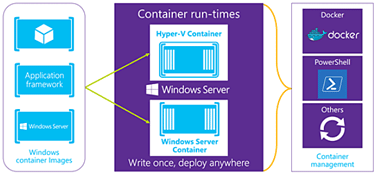Docker is required in order to work with Windows containers. For developers planning to do lots of Docker Windows container development it may also be worth setting up a Windows Server 2016 dev system in a VM for example at least until Windows 10 and Docker for Windows support for Windows containers matures.
 What Is Windows Containers Webopedia
What Is Windows Containers Webopedia
Additionally developers can leverage Docker natively with Windows 10 via Docker Desktop.

Windows server containers. What about operating system environment licensing when you use Windows Server Containers. Windows Server containers share the underlying OS kernel which makes them smaller than VMs because they dont each need a copy of the OS. They provide a high degree of isolation between workloads but are not meant to protect against hostile workloads.
Windows Server containers share the OS kernel with the container host and with all other containers that run on the host. Containers are portable and versatile can run apps written in any language and theyre compatible with any machine running Windows 10 version 1607 or later or Windows Server 2016 or later. To install Docker well use the OneGet provider PowerShell module.
In a Windows Server operating system after you enable the containers feature you install the Docker Engine. Windows Containers share a kernel with the container host and all the containers running on the host. With these updates you can automate building updated container images or manually update them by pulling the latest version.
Docker consists of the Docker Engine and the Docker client. All Windows Server 2016 and later versions come with Docker Engine - Enterprise. Windows Server Containers are the next level in server virtualization and prove to be very useful.
Therefore every month we rebuild the Windows Server Base OS container images with the updates and publish the updated container images. Microsoft Windows Server containers. The provider will enable the containers feature on your.
Same Docker CLI API image format and content distribution services. Container architecture on Windows Server involves several layers and utilizes the Docker Engine to work with containers. Ad Create Sophisticated Network Topologies.
Windows Server containers vs. Windows Server Containers are meant for enterprise multi-tenancy. Windows Server Container Licensing The best place to look for Windows Server Container licensing rules are the Product Terms.
Windows Server containers in Azure Kubernetes Service AKS are now generally available. For more information on how to install and configure extensions check out the Windows Admin Center documentation. Containers on Windows documentation.
Many customers are looking to adopt Kubernetes and AKS as their primary compute platform and have existing Windows applications that theyd like to manage using the same tools and processes. Windows Server containers do not have a servicing stack and do not support in place updates like Windows Server or Windows client. You can use Windows Admin Center to properly set up a Windows Server machine as a container host.
As part of servicing each month we publish updated Windows Server Base OS container images. Docker Windows containers work the same way as it does on Linux. With the Containers extension installed target the.
New Windows Server Base OS container images go live shortly after 1000am PST on the second Tuesday of each month in the Microsoft Container Registry MCR and the featured tags target the most recent B release. Enhance Security Isolation. Developers can create and test a container locally on their laptop or desktop and then deploy that same container image to their companys private cloud public cloud or service provider.
Learn how to use Windows containers with our quick start guides deployment guides and samples. What this means is that Windows Containers are isolated from each other but they run directly on Windows Server 2016. Windows Server 2016 is the where Docker Windows containers should be deployed for production.
The Docker Engine is responsible for. Over the years weve seen the adoption of this image grow and one of the feedbacks on it was the support lifecycle - for customers running on a Windows Server 2019 host the corresponding Nano Server 1809 image had the support lifecycle ending back in November 2020. But here comes the tricky part.
This document details deploying a Windows container host to either Windows Server 2016 or Windows Server Core 2016 on a physical or virtual system. Enhance Security Isolation. Nano Server has been our recommended base container image for new modern applications since its launch with Windows Server 2016.
Windows containers allow users to package applications with their dependencies and leverage operating system-level virtualization to provide fast fully isolated environments on a single system. These containers provide app isolation through the process and namespace isolation technology. To get started ensure you have the latest Containers extension installed on your Windows Admin Center instance.
Hyper-V containers are our solution for hostile multi-tenancy. In contrast with Hyper-V Containers the kernel of the container host is not shared with the Hyper-V Containers. Ad Create Sophisticated Network Topologies.
Windows Server 2016 supports two types of containers. Although Windows Server containers and Hyper-V containers do the same thing and are managed the same way the level of isolation they provide is different.


